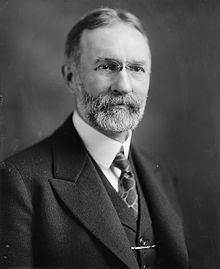George Sutherland
| George Sutherland | |
|---|---|
 |
|
| Associate Justice of the Supreme Court of the United States | |
|
In office September 5, 1922 – January 17, 1938 |
|
| Nominated by | Warren Harding |
| Preceded by | John Clarke |
| Succeeded by | Stanley Reed |
|
United States Senator from Utah |
|
|
In office March 4, 1905 – March 4, 1917 |
|
| Preceded by | Thomas Kearns |
| Succeeded by | William King |
| Member of the U.S. House of Representatives from Utah's At-large district |
|
|
In office March 4, 1901 – March 3, 1903 |
|
| Preceded by | William King |
| Succeeded by | Joseph Howell |
| Personal details | |
| Born |
Alexander George Sutherland March 25, 1862 Stony Stratford, England, UK |
| Died | July 18, 1942 (aged 80) , Massachusetts, U.S. |
| Political party |
Liberal (1883–1896) Republican (1896–1942) |
| Spouse(s) | Rosamond Lee |
| Children | 3 |
| Education |
Brigham Young University, Utah (BA) University of Michigan, Ann Arbor |
Alexander George Sutherland (March 25, 1862 – July 18, 1942) was an English-born U.S. jurist and politician. One of four appointments to the Supreme Court by President Warren G. Harding, he served as an Associate Justice of the U.S. Supreme Court between 1922 and 1938.
Sutherland was born in Stony Stratford, Buckinghamshire, England, to a Scottish father, Alexander George Sutherland, and an English mother, Frances, née Slater. A recent convert to The Church of Jesus Christ of Latter-day Saints (LDS Church), Alexander Sutherland moved the family to Utah Territory in the summer of 1863. Initially Alexander Sutherland settled his family in Springville, Utah, but moved to Montana and prospected for a few years before moving his family back to Utah Territory in 1869, where he pursued a number of different occupations. In the 1870s the Sutherland family left Mormonism, with George remaining unbaptized.
At the age of twelve, the need to help his family financially forced Sutherland to leave school and take a job, first as a clerk in a clothing store, then as an agent of the Wells Fargo Company. Yet Sutherland aspired to a higher education, and in 1879 had saved enough to attend Brigham Young Academy. There he studied under Karl G. Maeser, who proved an important influence in his intellectual development, most notably by introducing Sutherland to the ideas of Herbert Spencer, which would form an enduring part of Sutherland's philosophy. After graduating in 1881, Sutherland worked for the Rio Grande Western Railroad for a little over a year before moving to Michigan to enroll in the University of Michigan Law School, where he was a student of Thomas M. Cooley. Sutherland left school before earning his law degree.
...
Wikipedia
